Bell Logo
History
NOTICE:
All logos shown here are registered trademarks (TM) and the property of
the Regional Bell Operating Companies, Lucent, AT&T or Bell Labs.
They are shown here for historical/archival purposes only. This web
site and the server where these files are stored are not affiliated with
any of the above mentioned trademark owners nor do the use of the logos on
this web page constitute any commercial or for-profit use. For Bell
trademark information, see
bell.com

We Offer Personalized One-On-One
Service!
Call Us Today at (651) 787-DIAL (3425)


The Creator of
the Bell and AT&T Logos
"The [Bass & Yager] design
firm had created the famous bell symbol for the nationwide phone monopoly in the
late 1960s. This icon--which achieved a remarkable 93 percent recognition rate
in the United States [emphasis added] --aspired to the simplicity and directness of a sans serif
letterform. In 1984, the familiar bell symbol was transferred to the divested
"Baby Bells," and Bass & Yager designed a striated sphere for
AT&T, aiming to signify the corporation's international stature and the ascendance
of digital communications." - AT&T
Click
HERE to view the
history of Saul Bass, and his notable achievements in film and design. Due
to the achievements of Saul Bass, including his design of the Bell System
Stationery Manual and Graphic Standards Manual and iconic Bell logo in 1968, as
well as the 1982 AT&T "death star" logo that would become the post-divestiture
identity of AT&T from 1984 onwards.
A
book about Saul Bass and his unique designs was published in November of 2011,
and is available the the Bell System Memorial site. Simply click on the
Amazon link, and you will be taken to the dedicated page for; "Saul Bass: A Life
in Film & Design", authored by his daughter, Jennifer Bass, and Pat Kirkham.
"The design development of the AT&T globe symbol began in late 1982, with the
agreement between AT&T, the U.S. Department of Justice, and Federal District Court Judge Harold M. Greene that AT&T would divest itself of the 22 Bell Operating telephone companies as of January 1, 1984. Initially, the globe symbol was shown in conjunction with the logotype "American Bell" to identify an AT&T subsidiary providing terminal equipment and enhanced service on a unregulated basis. Later, Judge Greene ruled that the
'Bell' identification must be assigned exclusively to operating companies. Thus, the symbol was joined with the new name and logotype
'AT&T' to form the identification signature for the restructured AT&T.
The globe symbol was designed by Saul Bass of Bass/Yager & Associates. Literally dozens of symbol concepts were explored. The concepts were presented to the highest levels of AT&T management along with the design firm's recommendations as to which concepts should be considered the most promising candidate designs. It was from this group that the globe symbol was chosen to become the keynote graphic identification for AT&T.
The globe symbol symbolizes a world circled by electronic communications. More
specifically, the symbol is made up of very carefully delineated 'highlight' and
'shadow' elements. As a result, the symbol may be reproduced to give the
impression of a three-dimensional sphere that is lighted from a distance
source." From the
AT&T
Logo History web page (there is a neat Bell logo to AT&T logo
animation on that page worth viewing as well).
The
AT&T Corporate
Signature web page and
AT&T Brand Center (which links to the above mentioned History page)
contains detailed information about the media applications, appearance, and
standards that should be followed for the AT&T logo/name.
The
2010
AT&T
Information Services phone directories in the AT&T
Southeast, (former BellSouth) region, has released their new phone directories
with the history of the Bell and Bell logos. Thank you to David Massey for
sending us this page.
Bell System logo redesign, by Saul Bass
Click
HERE for a 1969 newspaper clipping about
the project.
According to AT&T, the Bell System redesign was the largest corporate
re-identity program in the U.S., ever. The redesign covered 135,000 Bell System
vehicles, 22,000 buildings, 1,250,000 phone booths, and 170,000,000 telephone
directories.


The new AT&T logo (post divestiture)
started out with 24 versions and a complex set of rules for its proper usage.
This became a real problem for AT&T to deal with and so in the October 6, 1987
issue of the corporate magazine called "FOCUS", they published an article that
discussed the logo issue with the employees. To view this article click
HERE.
Later, in about 1999, AT&T decided to use
a constant eight lines in the logo regardless of the size of the logo in printed
form.
In 2005 AT&T merged with SBC to form a
"new" AT&T. A short animation of the emergence of the new AT&T logo can be
viewed by clicking
HERE. The
logo history involving SBC and AT&T is shown in two PDF documents released on
November 21, 2005 when they unveiled the new logo. You can view these
documents by clicking
HERE and
HERE.

|

Bell Logo, 1969
Designer: Saul Bass (19201996)
Firm: Saul Bass & Associates, Inc.
|

AT&T Logo, 1984
Designer: Saul Bass (19201996)
Firm: Saul Bass & Associates, Inc. |
UPDATE: On November
21, 2005 the new AT&T logo was unveiled:
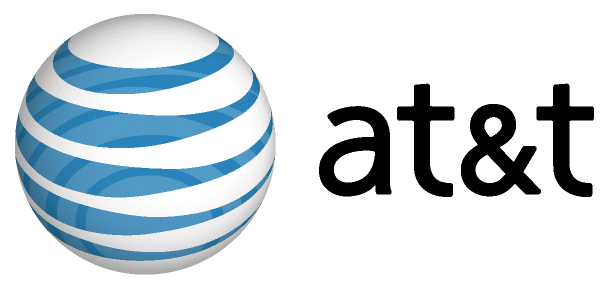

UPDATE: 2016 a revised AT&T logo was unveiled:
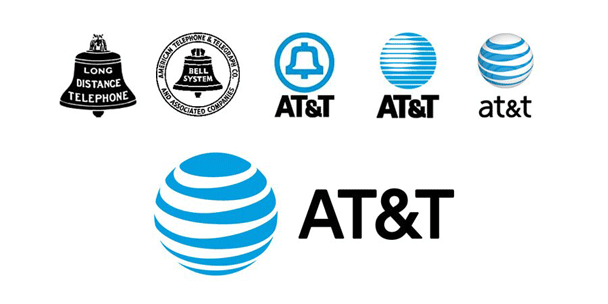
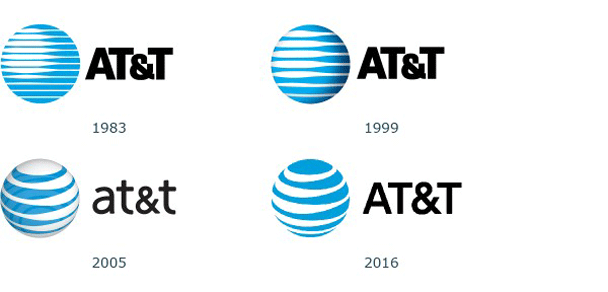

New! As
part of our re-design project, we have carefully recreated the Bell Logos in
their original format. We have all of the logos that the Bell System used
in 1970's and early 1980's in the following formats: Adobe Illustrator, Adobe
Photoshop and in (.gif). We are working on the other logos, however the
Bass & Yager version is the most complete version we have. Simply
click on the appropriate logo and you will be redirected to the Bell Logo
Downloads page. (Download site will be unavailable until August 24th due
to upgrades.)
|
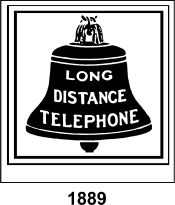
The first Bell logo
is adopted. |
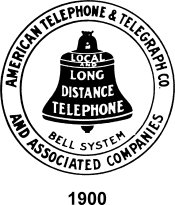
The second Bell logo
is introduced.
|
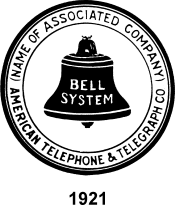
The third Bell logo
is instituted. |
|
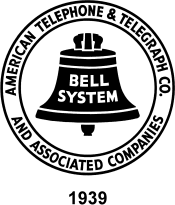
The fourth Bell logo
is inaugurated. |
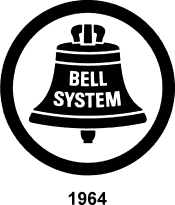
The fifth Bell logo
is installed. |
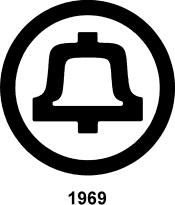
The sixth and current
Bell logo is unveiled. |

Along with the modern-day Bell logo,
the Bell System also unveiled the famous
yellow/gold (ochre: Red=243 Green=207
Blue=29 or Hex= #F3CF1D) and "process
blue" (Red=0 Green=145 Blue=201 or Hex= #0091C9) color stripes in
1969 (similar to what you see at the top of this paragraph.) The
stripes appeared on company vehicles, hard hats, etc.
What people think is gold is actually "ochre" (their form of yellow/gold) which
was developed from a derivative of the old gold that was used in the earlier
decals. The blue is also unique and both are still manufactured to the
original specs. The blue is a form of process blue.
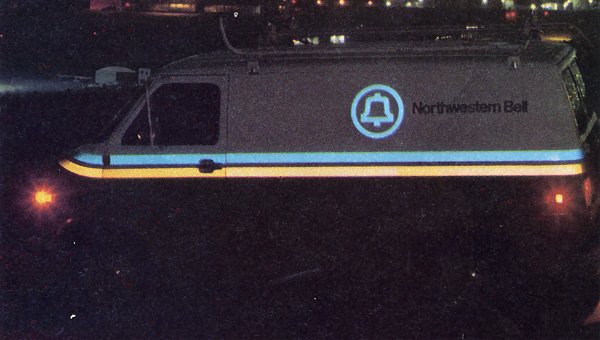
Click on image above to view entire 3M
advertisement (contributed by John S.
Flack)
Scanned from page 24 of the May 24, 1982 issue of "Telephony - International
Issue"
Bell was always an innovator, reflective sheeting material was used by them on
their original 1939 bell decal and on every vehicle ever since, even through
today. It has been reduced to one white reflective stripe on Verizon
vehicles.

Click on image above to view entire 3M advertisement (contributed
by John S. Flack)
Scanned from page 21 of the May 24, 1982 issue of "Telephony - International
Issue"
The 1969's new look was all about visual communication. Blue was to be the new
symbol of telecommunications (the future) as well as the change in the Bell
logo. The ochre represents a remembrance of the past (notice Blue is atop the
ochre) and then there was the gray/green bottom also so the public could
recognize the truck as a telephone company vehicle. That color would also carry
through to many other company pieces of equipment such as cross boxes, protector
housings etc. That was so it would be recognized as telephone company equipment.
By branding all vehicles with the new look was to bring about a friendlier
appearance to the company and get away from that military look. Today visual
communication has turned to red and black for telecommunications; just look at
the many smaller telcos such as Sprint, Cablevision etc.
The above information on the stripes was contributed by John Stallone (ATCA
member #3315)
The older Bell System vehicles were painted a
military-looking camouflage color. The official color of this Bell System
paint was Sherwin Williams "Bell System Green-grey, JX-6047". Thanks to Tim Fox
for this information!
The following article introducing the 1969 change in the Bell Logo and
introduction of the blue and yellow stripes appeared in the September/October
1969 Bell Telephone Magazine publication:
"The stylized bell in the circle and the colorful truck below give a thumbnail
preview of what is to come for visible parts of the Bell System plant such as
cars, trucks, public phones and business offices. Crisp blue and yellow
stripes will mark the new design for vehicles, separating the white
heat-reflecting top from a grey-green bottom. The revised Bell seal will be
used with simple, easier-to-read lettering to identify the various Bell
companies and will appear on stationery and phone bills. Because of the
nationwide size of the task, the cutover to the new designs and symbols will
be gradual, with most changes taking place over a five-year period. Some items
must undergo more experiment; some field testing is needed; economic
decisions, as distinct from design decisions, must be made. But the paint
shops and sign makers already have started to transform the Bell System's
face."
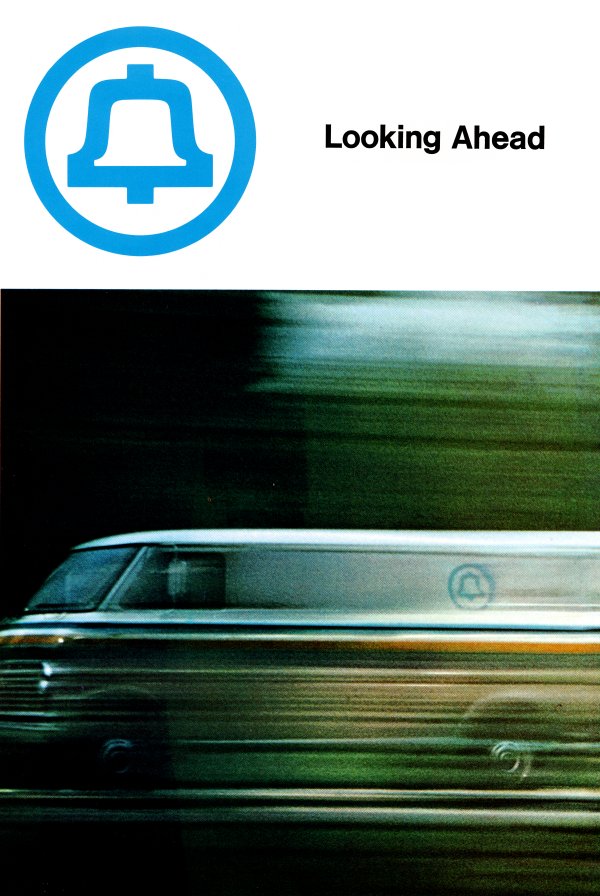
Click on image above to view high resolution scan of 1969 logo.
Webmaster's Note: The Bell Telephone System
undertook the largest Corporate Identity Program in the United States of
America. Project consisted of redesign of 135,000 Bell System fleet vehicles;
22,000 buildings 1,250,000 phone booths; 170,000,000 telephone directories.
With, 1,060,000 employees; 80,000,000 customers. It took
five years to implement this program - from 1969-1972 - and without the aid of
computers!

A scan is downloadable/viewable of
the AT&T logo changes (similar to above but with the additional change in
1984 of AT&T's logo since the courts prohibited them to use the Bell logo
after divestiture.) The original copy I received from AT&T was not of
high quality - looked like a copy of a copy of a copy! So there is a lot
of distortion in the logo dimensions (some look egg-shaped!). Click
HERE
to view or download the PDF file or
HERE
to download the GIF file format.
Another scan of a Bell logo history document
dating back to sometime between 1939 and 1963 can be viewed
HERE (thanks to
Ross Hamilton).

The Bell symbol History
The Chronology
Reference: Bell Atlantic
In Boston, on March 10, 1876, Alexander
Graham Bell transmits the first complete message - "Mr. Watson, come here, I
want you!" - with the use of his invention, the telephone.
About two years later during the period from July 30,
1878 to April 17, 1880, a series of Massachusetts corporations controlling
Mr. Bell's patent rights are organized. Bell Telephone Co., is the first of the
corporations and is soon superseded by National Bell Telephone Co., which is
replaced with American Bell Telephone Co. These firms supply telephone
instruments to Bell-licensed exchange companies across the country. The
Bell-licensed exchange companies then rent the telephone instruments to local
subscribers.
Then on March 3, 1885, the American Telephone and
Telegraph Co. (now known as AT&T) is established as a subsidiary of American
Bell Telephone Co. Because the firm connects remote exchanges, it is popularly
called the long-distance company.
1889 - First Bell logo
Alexander Graham Bell's original telephone patents expire
during the years 1893 and 1894. Many independent telephone
companies were formed after the expiration of Bell's patents and there is fierce
competition for the next 20 years.
On December 30, 1899, AT&T succeeds American Bell
as the parent of the Bell System. In general, the system's division of labor is
as follows: AT&T provides overall support and direction for the other companies
in the Bell System, its Long Lines Department manages long-distance service,
Bell Telephone Laboratories (formed in 1925) conducts research and development,
Western Electric Co. manufactures communications equipment and the Bell
operation companies provide local telephone service.
1900
- Second Bell logo
The Interstate Commerce Commission (ICC) assumes
jurisdiction over interstate telephone companies on June 18, 1910.
The U.S. Department of Justice files an antitrust suit
against AT&T on July 24, 1913. The complaint charges AT&T with conspiracy
to monopolize and restrain trade in the northwestern states of the USA.
Then later that year on December 19th, AT&T Vice President Nathan
Kingsbury agrees to provide long-distance connection of Bell System lines to
independent phone companies in a letter to the U.S. attorney general. He
further agrees not to purchase competing independent without prior ICC approval.
This letter is commonly known and the "Kingsbury Commitment". A consent
decree ends the antitrust suit against AT&T on March 26, 1914.
The U.S. government runs the telephone system during the
only time in American history from July 1, 1918 to June 30, 1919.
The postmaster general serves, in effect, was a super-chief
executive officer, although Bell System personnel handle daily operation.
1921 - Third Bell logo
The first broadcast of a football game (University of
Chicago v. Princeton) is sent in October of 1922 over telephone wire from
Chicago to New York City.
President Franklin D. Roosevelt signs the Communications
Act on June 19, 1934. The law places interstate telephone business under
the regulation of the newly formed Federal Communications Commission (FCC).
1939 - Fourth Bell logo
The U.S. Department of Justice files suit against AT&T on
January 14, 1949, charging that it conspired with Western Electric to
monopolize trade in telephone equipment. The lawsuit attempts to separate the
Bell System's manufacturing arm from its research and operating functions.
Over two and one third trillion - 2,300,000,000,000 -
telephone calls go through Bell Systems central offices from 1950 to 1975.
A consent decree on January 24, 1956 bars AT&T from
engaging in unregulated businesses, brings to a close the Justice Department's
antitrust suit against the company. Western Electric remains AT&T's largest
single subsidiary.
1964 - Fifth Bell logo
The FCC reaches its
Carterfone decision on June 26,
1968. Carter Electronics of Dallas sought to interconnect its two-way radios
with the nationwide phone system. The ruling strikes down interstate tariffs
that prohibit attachment or connection of non-Bell System communications
equipment to the public network. And it opens the way for competition in the
customer-owned equipment market.
1969 - The sixth and current Bell logo
On August 13, 1969 the FCC approves the application
of Microwave Communications, Inc. (MCI) to build a private line microwave
communications system between Chicago and St. Louis. The action ultimately
stimulates full competition in the long-distance phone business.
In 1971, Illinois Bell introduces Call Waiting,
Three-Way Calling, Call Forwarding, and Speed Calling.
The Justice Department files a final antitrust suit
against AT&T on November 20, 1974, charging monopolization of the
telecommunications service and equipment markets.
In May of 1977, the test of the world's first
network application of fiber optics begins in Chicago. The test proves that
customer calls can be transmitted using light waves.
On January 8, 1982 [webmaster's note: I believe
there is an error on the bell.com website which states the month and date as
August 8] a federal court approves a consent decree breaking up the Bell
System into local and long-distance telephone companies. AT&T agrees to divest
itself of all Bell operating companies. The issue of which companies would
retain rights to the Bell mark and logo is later decided in favor of Cincinnati
Bell, Southern New England Telephone Co. (SNET) and the new holding companies,
also called Regional Bell Operating Companies (RBOCs).
The Bell System came to an end on January 1, 1984.
As a result of divestiture, the seven RBOCs - Ameritech, Bell Atlantic,
BellSouth, NYNEX, Pacific Telesis Group, Southwestern Bell Corp. and US West -
become the parents of 22 local Bell companies. Cincinnati Bell and SNET, which
were not wholly-owned subsidiaries of AT&T, carry on as distinct firms. 1984
coverage map.
President Clinton signs the Telecommunications Act of
1996 on February 8th. The law calls for the opening of local and
long-distance telephone and cable television markets to full competition.
[Webmaster's note: This 1996 law has probably done more harm to the consumer and the
telecommunications industry than the breakup of the Bell System]

A scan of the old Southern Bell logo
can be viewed/downloaded by clicking
HERE.

The
AT&T Long Lines Department was responsible for connecting the
local Bell companies together to provide long distance telephone communication
between each Bell company. Here are two logos representing the time period
between 1939 and 1963 and the time period after 1969. The one on the left
was derived from an original scan by Reynolds Hedland.
|
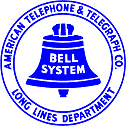
Click on image above for full-size view |

|


recently became...
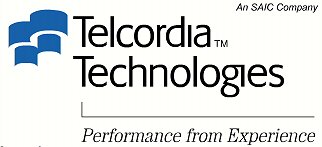

YELLOW PAGES
LOGO
In 1961, the walking fingers logo
was introduced to encourage consumers to "let their fingers do the walking"
through the Yellow Pages. It became one of the most recognized and well-known
advertising themes of all time. One of the
biggest corporate oversights in history was AT&T's failure to trademark this
symbol. Therefore, the walking fingers logo is in the public domain.

(click on image above to view full-page
advertisement for the Yellow Pages)
In 1998, the walking fingers logo
was dumped by BellSouth Yellow Pages and others for a new logo that incorporated
a light bulb and the tagline, "Get an idea."
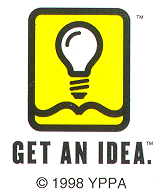
The "Get an Idea" campaign was suspended two years
later and now it's back to the original Walking Fingers logo!

SBC and BellSouth created a joint venture, merging their respective online
directory businesses. SBC's SMARTpages and BellSouth's Real Yellow Pages
merged to form yellowpages.com. After SBC merged with AT&T Corp. in 2005,
SBC then became AT&T Inc. and a year later acquired BellSouth. As a
result, the "New AT&T" has included the walking fingers within the
yellowpages.com logo, heralding back to the days when the original AT&T came up
with the logo in 1961.

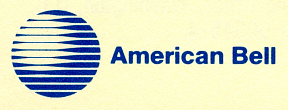
American Bell was a trial subsidiary of AT&T
in 1983, but did not last six months.
There was an article in Bell Telephone
Magazine (last issue for 1982) that announced the startup of American Bell.
Click HERE to read the article.

And
we received the following information
from one of the former employees of American Bell:
Hi,
I'm an ex-AT&T
employee;
You might be interested that it's slightly incorrect
(although not surprising at the time). The (new) American Bell was actually
started six months earlier than the date in this memo, on July 1 1982. It
originally held the Net 1000 service with about 1000 employees; an additional
27,000 employees joined six months later as reflected in the cited memo.
Unfortunately, I don't have any paper documentation to
prove that, nor have I found anything on the web. However, as one of the first
group of 1000, I have a sterling silver American Bell logo (which we recognize
as the post-divestiture AT&T "death star" logo), engraved on the back with the
name American Bell, my name, the date, and the mantra "first to be chosen".
[All 1000 of us received such mementos.] I'd be happy to provide you with a
digital photo if you're interested.
The reason I'm not surprised about the error in the memo
is that the July 1st group wasn't widely known in AT&T. Soon after Archie
McGill took over at head of one division of American Bell on Jan 1 1983, he
visited our facility in Lincroft NJ and expressed surprise that our group
preceded him in American Bell.
Things were very strange in the "fully separated
subsidiary", as we were known. Initially, we couldn't use the library in our
building (still owned by Bell Labs), nor could we be with Bell Labs people in
official vanpools! It wasn't clear initially how separate we had to be to meet
the FCC's regulations, so we weren't supposed to share anything without a
manager's approval!
Thanks for a great site!
- Jeremy Epstein
Senior Director, Product Security & Performance
P 703.460.5852 | C 703.989.8907 | F 703.460.2599 | W
202.456.1111 AIM jeremyepstein | Skype jjepstein
www.webMethods.com



Click image above to see enlarged view

Bell Canada's
Logo
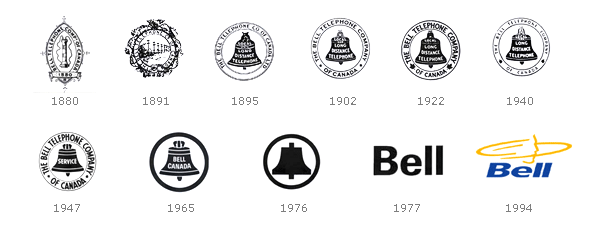
Our mission is clear: to be recognized by customers as
Canada's leading communications company. Our brand needs to suit a leader:
optimistic, inspirational, credible and clear.
This site gives you the tools you need to create
communications which reflect 'inspired optimism'. Use them every day in
everything you do and with a bit of practice, your communications will just get
better.
More information on Bell Canada's brands,
logos and trademarks can be found by clicking
HERE.

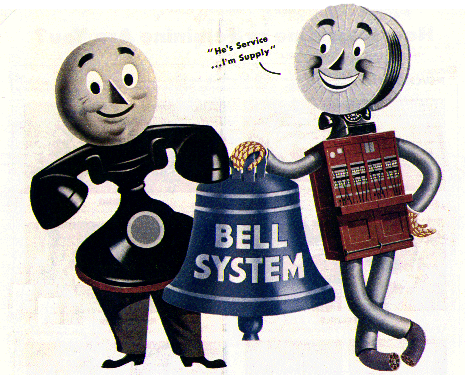

For a
brief history of Bell System signs, please visit this web site:

|

